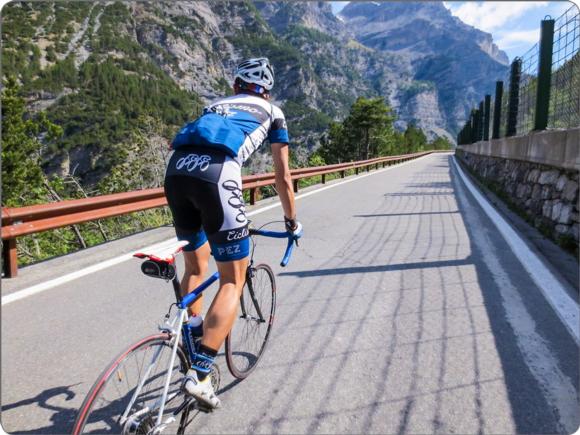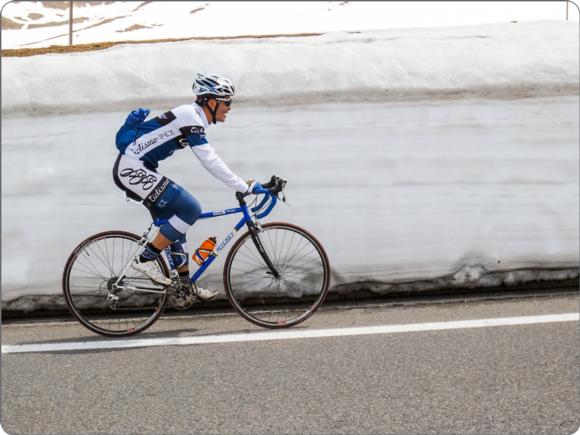Proper climbing form for cyclists
This is an excerpt from Cycling Science by Stephen S Cheung,Mikel Zabala.
How the cyclist rides the bicycle while climbing is a critical component of success, so form while climbing should be the best it can be. To climb well, cyclists need to address five major aspects of form, in this order:
- Center of gravity
- Arms and shoulders
- Action of gluteal muscles
- Pedaling action
- Spine and back
Climbing also has to be broken down into standing and seated climbing. Clearly, each technique requires different muscle groups, different centers of gravity, and different breathing actions. Let's tackle standing first.
Standing Climbing
Cyclists stand while climbing for several reasons: to produce more power, to handle a steeper section better, to rest the muscles used while seated, and to use body weight to help in the climb. When standing, heart rate typically rises because the cyclist uses more upper-body muscle to wobble the bike back and forth. Engaging the upper body requires the delivery of more oxygen to the working muscles, and the heart responds by pumping faster to get more blood to those critical areas. This response can be a problem if the cyclist is already at threshold. Any rise in heart rate might cause the cyclist to go over the edge and blow up, so cyclists need to know when to stand up and when to stay seated. One rule to stick with is to stay seated as long as possible when the pace is steady to help reduce heart rate and maintain pace. When the pace begins to change because of having to respond to other riders or changes in terrain, that generally signals the time to get out of the saddle to increase power.
As seen in figure 14.1, when standing, the cyclist should shift his or her body weight farther forward on the bike, both because the bike is already tilting backward from the gradient and because the forward position allows the rider to increase leverage. To do this, rather than just bending at the hips and dropping the chest toward the stem, the cyclist should think instead of pushing the pelvis toward the stem and straightening the arms to help reduce some of the energy needed by the arms to hold up the upper body. Giro 1988 winner Andy Hampsten demonstrated excellent climbing form while standing.

Proper standing form. Note that the pelvis is well forward of the saddle and the rider's chest is erect, such that breathing is open and much of the body weight is on the skeleton rather than the muscle of the arms.
Courtesy of PezCyclingNews.com.
By standing straighter with the pelvis pushed forward, the cyclist can easily rest the upper body, almost, but not quite, locking the arms and allowing the body weight to fall on the downstroke. The cyclist should practice this when not riding at high intensity and just climbing easy to get the feel of the body weight falling on each side in slow motion. The back should be straight and elongated, and the chest should be open to help the lungs take in the maximum amount of oxygen. This action will be a little choppy with a lower cadence when first practiced, but when the cyclist gets the feeling and hang of it and then applies it to a faster cadence and higher power, he or she will be smoother while still being able to relax and apply more force than when seated.
Seated Climbing
Seated climbing allows the cyclist to reduce upper-body movement and concentrate solely on power output from the legs. By relaxing the arms and shoulders (by dropping the shoulders down from the ears) and opening the chest (by letting the chest lead), the cyclist can recruit gluteal muscles at a higher level, as well as the hamstrings and quadriceps. The seated position also provides a little more range with cadence, because pedaling faster while seated is much easier. Figure 14.2 shows an example of good seated climbing.

Proper seated climbing form. Upper body is loose and weight is set back on the saddle to permit fuller leg extension.
Courtesy of PezCyclingNews.com.
One of the biggest mistakes riders make while seated is that they grip the handlebars too hard and tighten their chest muscles to pull back on the handlebars. Pulling back on the handlebars is sometimes necessary to help engage the upper body to fire those leg muscles, but while climbing, having a more relaxed grip and an open chest is generally more economical. Pulling hard on the handlebars when climbing usually indicates the point at which the cyclist should get out of the saddle and climb while standing. One technique that I encourage in my athletes when they are climbing in the saddle is to slide a little farther back on the saddle and drop the heels slightly to better engage the hamstrings. This approach allows the upper legs (femurs) to act even more like a lever to concentrate force on the downward stroke of the crank arm. The result can be a 5- to 10-watt improvement in power output.
With seated climbing, one well-known piece of advice by Eddy Merckx comes to mind. When asked the best advice for climbing, he stated, "Ride on the tops of your handlebars and pretend you are playing the piano. This will relax the chest and arms and make sure you aren't pulling too hard on the bars." This suggestion makes a lot of sense, and although riding with the hands lightly touching the bars is not always reasonable, it reminds the cyclist to relax the grip, elbows, and shoulders, which helps her or him be more economical.
Two critical details can make the biggest difference in climbing ability. The first has to do with how the cyclist sits on the bike. Many riders sit on their seat as if they are sitting in an office chair. Their sit bones are pointing down, and they round the back so that they can reach the handlebars. This position causes stress on the back, and if done for many years, it may contribute to a herniated disc. The best way to sit on the seat is to roll the pelvis forward and keep the spine long and straight.
Try this experiment. Sit in a straight-back chair with your butt pushed up against the back of the chair. Now, with a flat and straight back, pivot your upper body forward and push your butt farther back in the "corner" of the chair. Rolling your pelvis forward keeps your spine straight and long, thus protecting your back while at the same time opening the gluteal muscles so that they can contribute significantly to creating power.
The second critical detail to address when climbing is allowing the chest to lead the bike. Many cyclists round their shoulders while riding, which reduces the space in which the lungs can expand. Rolling the shoulders back and down while puffing the chest out gives the lungs more space to expand. One of the best ways to learn this posture is to pretend that a thread is attached to your sternum and leading you forward. This invisible thread pulls the chest out and is attached in space about 2 meters in front of the wheel. Allowing the chest to lead the body helps to force a long, straight back and rolls the shoulders back and down. These details are critical for long-term comfort and proper pedaling.
Speaking of comfort, rolling the pelvis forward does change where the cyclist contacts the seat. The cyclist could have more contact between the seat and the perineum (space between the anus and genitals). At no time should the genitals ever become numb when riding. If this occurs, a new seat is needed to provide a better fit for the cyclist and his or her position. I highly recommend one that has a cutout in the middle to provide relief from the perineum being pinched on the saddle.
Learn more about Cycling Science.
More Excerpts From Cycling ScienceSHOP

Get the latest insights with regular newsletters, plus periodic product information and special insider offers.
JOIN NOW
Latest Posts
- Sample mental health lesson plan of a skills-based approach
- Sample assessment worksheet for the skill of accessing valid and reliable resources
- Help your students overcome what holds them back from making health-promoting choices
- Example of an off-season microcycle
- Modifying lifts
- Screening for multilevel programs in a team environment


